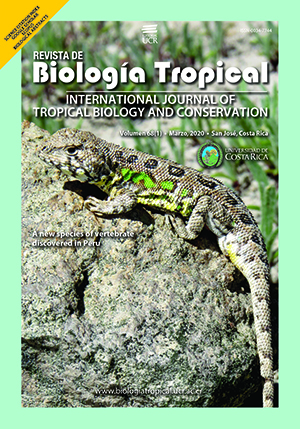Abstract
Introduction: Aquatic ecosystems in southern Brazil are presently under great environmental pressure. Changes in land use result in negative impacts on the ecosystem, affecting the functioning of stream communities. Objective: To compare the benthic macroinvertebrate community richness, abundances and compositions in streams of three South Brazilian grassland landscapes and correlate community patterns with environmental and spatial variables. Methods: Fifteen streams along riparian forests were selected in three landscapes (mean geographical distance of 285.1 km) inserted in the Paraná and Uruguai river basins. Of the three landscapes, two are inserted in conservation units (State Park of Guartelá and Palmas Wildlife Refuge). Invertebrates were collected in 20 kick net points along 150 m of the streams between June and November 2015. Invertebrates were sorted in the laboratory with three sieves and were identified to the lowest taxonomic level possible. The taxa were classified in functional feeding groups of shredders/detritivores, predators, scrapers, collectors/filters and gatherers/collectors. For each stream, we measured the environmental variables width and velocity, pH, dissolved oxygen, and temperature; and the relative cover of forest, grassland, plantation and silviculture in the catchments. Results: We found a total of 1 058 individuals, divided in 53 morphospecies and 34 families. Lower abundance of benthic macroinvertebrates was found in the northernmost landscape with higher temperature, and forest in the catchment. These streams were described mainly by predator groups, while streams inserted in the other two landscapes showed a more diverse guild composition of shredders/detritivores, gatherers/collectors, collectors/filterers, and scrapers. Geographical distance was the main factor influencing differences in community compositions among landscapes. Conclusions: Lower abundance of the northernmost landscape may be explained by (i) the low habitat heterogeneity due to dominance of sandy substrates, and by (ii) the anthropogenic land use of agriculture and extensive cattle breeding in the region that is ongoing and started before the creation of the conservation unit. Additionally, composition of macroinvertebrates may be correlated with environmental differences among landscapes that, in turn, are related to the geographical distance. Therefore, macroinvertebrate community responses may reflect different biota biogeographical histories that can also be associated with historical land use practices.
##plugins.facebook.comentarios##

This work is licensed under a Creative Commons Attribution 4.0 International License.
Copyright (c) 2020 Gabriela Galeti, Ronei Baldissera






